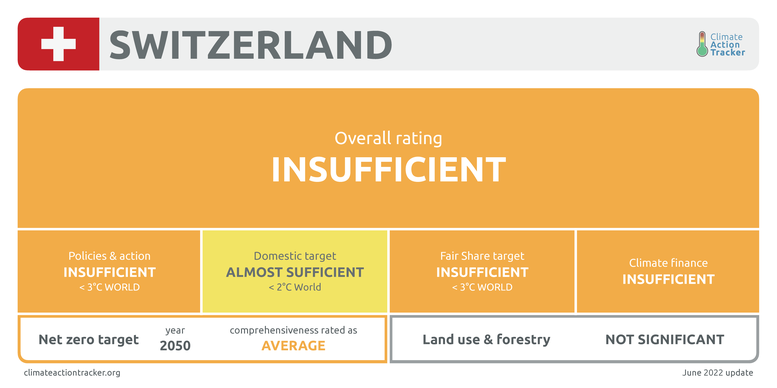CAT Climate Target Update Tracker
Switzerland
Summary
On 17 December 2021, Switzerland submitted a further update to its NDC to the UNFCCC. The update was necessary to address the uncertainty created when changes to its climate legislation (the CO2 Act) were rejected in a June 2021 referendum. Switzerland’s overall target remains unchanged at: ‘at least 50%’ below 1990 levels. The extent to which the target will be achieved domestically versus through the use of international carbon market credits is no longer quantified, in contrast to the previous NDC (December 2020).
Like its first update, this second update also includes Switzerland’s indicative 2050 net zero GHG target.
Switzerland’s overall CAT rating remains at ‘Insufficient’.
CAT analysis of NDC update

On 17 December 2021, Switzerland submitted a further update to its NDC to the UNFCCC. The update was necessary to address the uncertainty created when changes to its climate legislation (the CO2 Act) were rejected in a June 2021 referendum.
In its first NDC update (December 2020), Switzerland established a new floor for its NDC, moving from a 50% below 1990 levels by 2030 to ‘at least’ 50%. It also increased the extent to which this target would be achieved by emissions reductions at home from 60% of the target to 75% (equivalent to a 37.5% reduction from 1990 levels, up from 30%). The remainder of the target would be met through emissions reductions achieved abroad. This updated target was included in Switzerland’s third CO2 Act, but was subject to a facultative referendum. These changes were rejected by the Swiss population in June 2021.
The further NDC update (December 2021) maintains the new NDC target floor of ‘at least 50%’ below 1990 levels. However, it no longer quantifies the extent to which the target will be met with domestic emissions reductions versus those to be achieved using emissions reductions achieved abroad. Instead, the NDC states that its emissions reductions to 2030 will be “mainly achieved domestically”.
The CAT rates targets against what a country should be doing within its own borders (its ‘domestic target’) as well as what a fair contribution to achieving the Paris Agreement’s long-term temperature goal would be. For the fair share target, we consider both its domestic reductions as well as any emissions it supports abroad through the use of market mechanisms or providing climate finance (more details on the rating system are here). For the purpose of this assessment, we assume the domestic component of Switzerland’s target reverts back to the 30% that was approved by the Federal Council in 2014. We rate this domestic target as “Almost sufficient” when compared to global least cost modelled pathways. This target sits at the very top end of the “Almost sufficient” range (in contrast to the first NDC which was well within the Almost sufficient range).
The CAT rates Switzerland’s overall target of ‘at least 50%’ below 1990 levels as ‘Insufficient’ when compared to its fair share emissions allocation. The CAT also considers climate finance when evaluating a country’s total fair share contribution, however Switzerland’s level of climate finance (which we rate as ‘Highly insufficient’) does not improve its fair share rating.
Switzerland started signing bilateral agreements with other countries to achieve emissions reductions that can be counted towards the achievement of its NDC. The first such agreement was signed by the governments of Switzerland and Peru in October 2020, allowing Peru to implement sustainable development projects while Switzerland will count the resulting emissions reductions towards achievement of its 2030 emissions reduction target. Similar agreements were signed between Switzerland and Ghana in November 2020, and subsequently with Senegal, Vanuatu, Georgia, and Dominica.
To be 1.5°C compatible, Switzerland needs to cut emissions at home by at least 53% (slightly more than the entirety of its current NDC target) and support even more reductions abroad than it is currently planning.
Swiss government projections show that under current policies, it will not meet the domestic portion of its NDC target (which we assume to be 30%). Far greater policy ambition is needed, particularly in the transport sector which is responsible for almost a third of Swiss emissions. Emissions from the transport sector are currently still above 1990 levels.
The second NDC update reconfirms Switzerland’s net zero target (which had also been included in the first update). Switzerland submitted its long-term strategy to the UNFCCC in January 2021, although it will need to be updated to reflect the rejection of the proposed changes in Switzerland’s domestic emissions cuts (which feature prominently).
Work is underway to draft a replacement CO2 Act. Consultations on the new legislation is open until April 2022.

Links
Stay informed
Subscribe to our newsletter